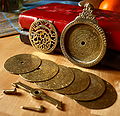File:Astrolabe, 18th century, disassembled.jpg
Appearance

Size of this preview: 618 × 600 pixels. Other resolutions: 247 × 240 pixels | 495 × 480 pixels | 791 × 768 pixels | 1,055 × 1,024 pixels | 2,110 × 2,048 pixels | 2,627 × 2,550 pixels.
Original file (2,627 × 2,550 pixels, file size: 6.68 MB, MIME type: image/jpeg)
File history
Click on a date/time to view the file as it appeared at that time.
| Date/Time | Thumbnail | Dimensions | User | Comment | |
|---|---|---|---|---|---|
| current | 21:29, 29 December 2009 |  | 2,627 × 2,550 (6.68 MB) | KJG2007 | {{Information |Description=the various parts of a 18th century astrolabe made in North Africa. astrolabe is a historical astronomical instrument used by classical astronomers, navigators, and astrologers. Its many uses included locating and predicting th |
File usage
The following page uses this file:
Global file usage
The following other wikis use this file:
- Usage on ar.wikipedia.org
- Usage on ca.wikipedia.org
- Usage on el.wikipedia.org
- Usage on et.wikipedia.org
- Usage on fi.wikipedia.org
- Usage on fr.wikipedia.org
- Usage on ko.wikipedia.org
- Usage on mk.wikipedia.org
- Usage on ms.wikipedia.org
- Usage on ta.wiktionary.org
- Usage on uk.wikipedia.org
- Usage on ur.wikipedia.org
- Usage on zh.wikipedia.org
